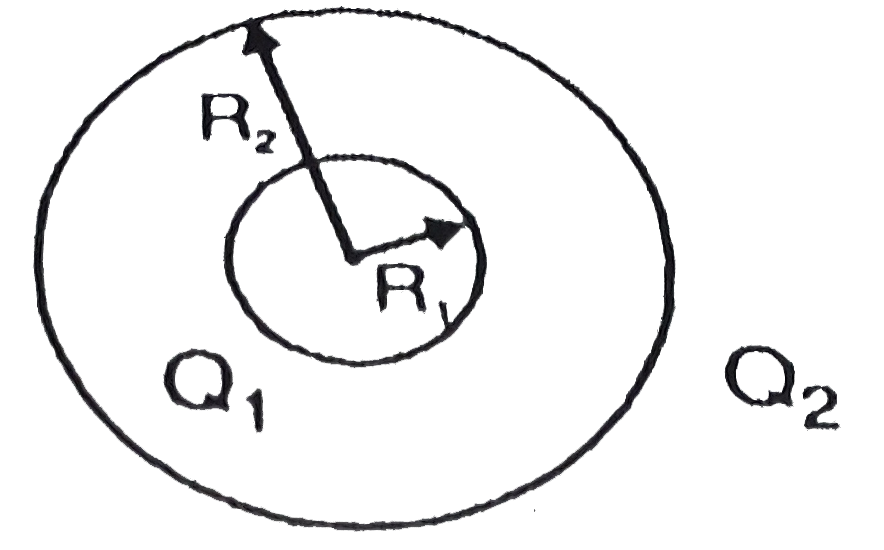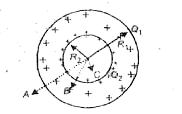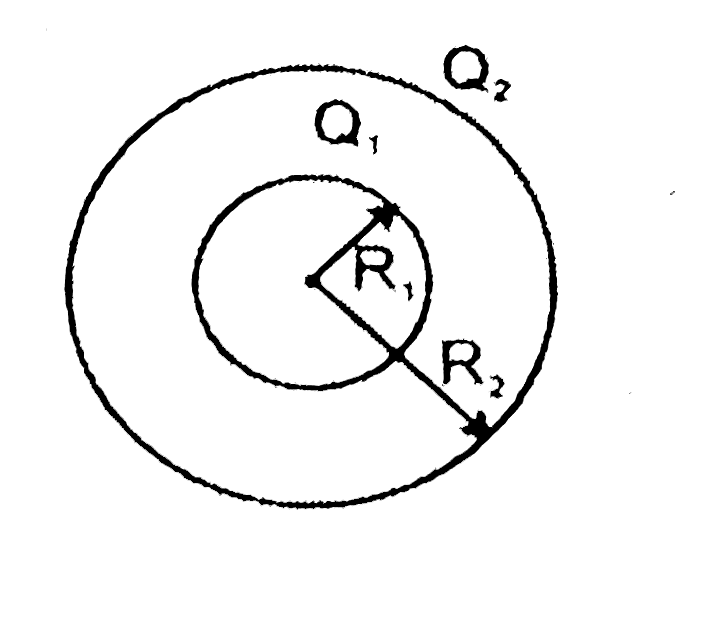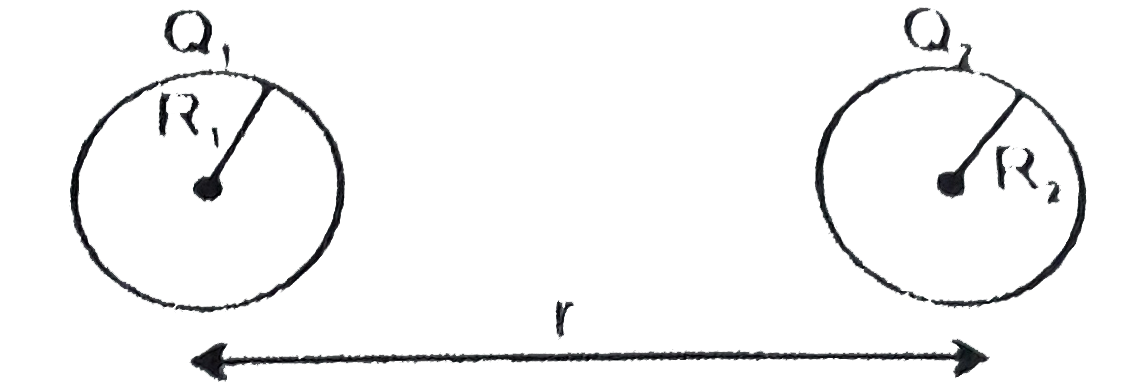Two concentric, thin metallic spheres of radii R1andR2(R1>R2) charges Q1andQ2 respectively Then the potential at radius r between R1andR2 will be (k=1/4π∈)
A) k(Q1+Q2r)
B) K(Q1r+Q2R2)
k(Q2r+Q1R1)
D) k(Q1R1+Q2R2)
The correct Answer is:C
To find the potential at a radius r between two concentric metallic spheres with radii R1 and R2 (where R1>R2) and charges Q1 and Q2 respectively, we can follow these steps:
1. Understanding the Configuration:
- We have two concentric metallic spheres. The outer sphere has a radius R1 and charge Q1, while the inner sphere has a radius R2 and charge Q2. The region of interest is between the two spheres, where R2<r<R1.
2. Potential Due to a Charged Sphere:
- The electric potential V due to a charged sphere at a distance r from its center (for r greater than the radius of the sphere) is given by:
V=kQr
- Here, k=14πϵ0.
3. Potential in the Region Between the Spheres:
- The potential at a distance r from the center due to the inner sphere (radius R2 and charge Q2) is:
V2=kQ2r
- The potential due to the outer sphere (radius R1 and charge Q1) is constant throughout the region outside the sphere and is given by:
V1=kQ1R1
- Since we are in the region between the two spheres, the potential due to the outer sphere V1 remains constant.
4. Total Potential:
- The total potential V at a distance r between the two spheres is the sum of the potentials from both spheres:
V=V1+V2=kQ1R1+kQ2r
- We can factor out k:
V=k(Q1R1+Q2r)
5. Final Expression:
- Thus, the potential at radius r between the two spheres is:
V=k(Q1R1+Q2r)
Conclusion:
The potential at radius r between the two concentric spheres is given by:
V=k(Q1R1+Q2r)
- We have two concentric metallic spheres. The outer sphere has a radius R1 and charge Q1, while the inner sphere has a radius R2 and charge Q2. The region of interest is between the two spheres, where R2<r<R1.
- The electric potential V due to a charged sphere at a distance r from its center (for r greater than the radius of the sphere) is given by:
V=kQr
- Here, k=14πϵ0.
- The potential at a distance r from the center due to the inner sphere (radius R2 and charge Q2) is:
V2=kQ2r
- The potential due to the outer sphere (radius R1 and charge Q1) is constant throughout the region outside the sphere and is given by:
V1=kQ1R1
- Since we are in the region between the two spheres, the potential due to the outer sphere V1 remains constant.
- The total potential V at a distance r between the two spheres is the sum of the potentials from both spheres:
V=V1+V2=kQ1R1+kQ2r
- We can factor out k:
V=k(Q1R1+Q2r)
- Thus, the potential at radius r between the two spheres is:
V=k(Q1R1+Q2r)
The potential at radius r between the two concentric spheres is given by:
V=k(Q1R1+Q2r)
Topper's Solved these Questions
- ELECTROSTATICSBook:AAKASH SERIESChapter:ELECTROSTATICSExercise:PRACTICE SHEET (EXERCISE -IV ELECTRIC POTENTIAL & POTENTIAL ENERGY) (LEVEL - II (ADVANCED) MORE THAN ONE CORRECT ANSWER TYPE QUESTION)
Explore 1 Video
- ELECTROSTATICSBook:AAKASH SERIESChapter:ELECTROSTATICSExercise:PRACTICE SHEET (EXERCISE -IV ELECTRIC POTENTIAL & POTENTIAL ENERGY) (LEVEL - II (ADVANCED) LINKED COMPREHENSION TYPE QUESTION)
Explore 2 Videos
- ELECTROSTATICSBook:AAKASH SERIESChapter:ELECTROSTATICSExercise:PRACTICE SHEET (EXERCISE -IV ELECTRIC POTENTIAL & POTENTIAL ENERGY) (LEVEL - I (MAIN) STRAIGHT OBJECTIVE TYPE QUESTION)
Explore 19 Videos
- ELECTROMAGNETICSBook:AAKASH SERIESChapter:ELECTROMAGNETICSExercise:ADDITIONAL EXERCISE
Explore 13 Videos
- ELEMENTS OF VECTORSBook:AAKASH SERIESChapter:ELEMENTS OF VECTORSExercise:QUESTIONS FOR DESCRIPTIVE ANSWERS
Explore 10 Videos
Similar Questions
The insulated spheres of radii R1 and R2 having charges Q1 and Q2 respectively are connected to each other. There is
View SolutionThe insulated spheres of radii R1 and R2 having charges Q1 and Q2 respectively are connected to each other. There is
View SolutionThe capacitance of two concentric spherical shells of radii R1 and R2(R2>R1) is
View SolutionTwo concentric spherical shells of radius R1 and R2(R2>R1) are having uniformly distributed charges Q1 and Q2 respectively. Find out total energy of the system.

View SolutionYou are given two concentric charged conducting spheres of radii R1andR2 such that R1>R2, having charges Q1andQ2 respectively and uniformly distributed over its surface. Calculate E and V at three points A, B , C whose distances from the centre are rA,rBandrc respectively as shown in figure.

View SolutionTwo concentric uniformly charge spherical shells of radius R1 and R2(R2>R1) have total charges Q1 and Q2 respectively. Derive an expression of electric field as a function of r for following positions.
(i) r<R1 (ii) R1≤r<R2
(iii) r≥R2

View SolutionTwo metallic s pheres of radii R1 and R2 are connected b y a thin wire. If +q1~and+q_(2) are the charges on the two s pheres then
View SolutionTwo non-conduction hollow uniformly charged spheres of radil R1 and R2 with charge Q1 and Q2 respectively are places at a distance r. Find out total energy of the system.

View SolutionTwo charged spheres of radii R1andR2 having equal surface charge density. The ratio of their potential is
View SolutionTwo concentric conducting shells of radii R and 2R are having charges Q and -2Q respectively.In a region r
View Solution
